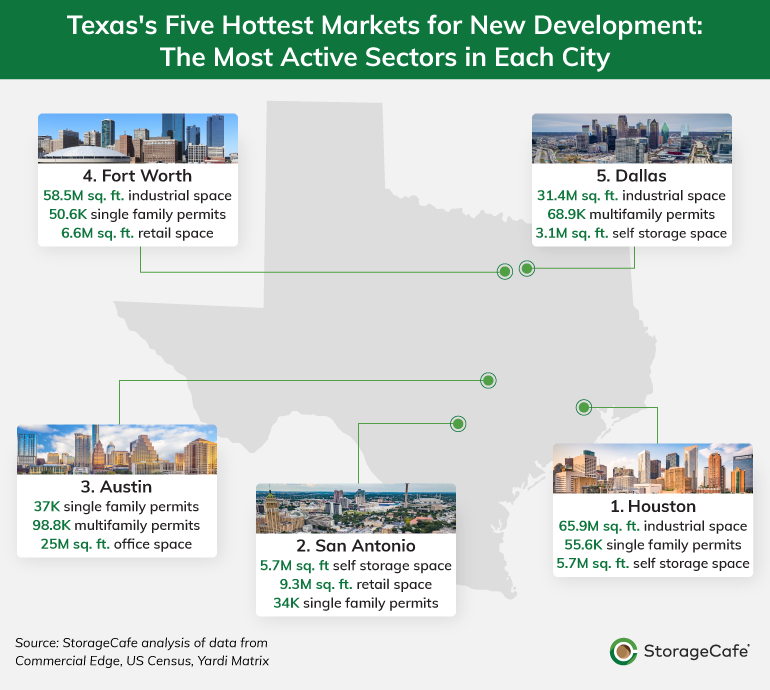Article by: StorageCafe
Fort Worth, Dallas, Among the Country’s Top 5 Cities for Real Estate Development
The Dallas-Fort Worth (DFW) metro area consistently ranks among the fastest-growing regions in the United States, with its population and economy expanding at an impressive rate. The surge in employment opportunities, fueled by the presence of major corporate headquarters, burgeoning industries and an entrepreneur-friendly environment, attracts a steady influx of professionals seeking to capitalize on the region’s economic prosperity.
As a result, the demand for housing and commercial spaces has skyrocketed. From gleaming high-rise condominiums to sprawling master-planned communities, as well as new industrial or self-storage space, the region has undergone an intense metamorphosis. Recent StorageCafe research ranked the country’s largest hundred cities for real estate development over the past decade, and Fort Worth and Dallas city proper landed on the fourth and fifth positions, respectively.
The research looked into building permits for single-family and multifamily units, as well as the square footage of industrial, self-storage, office and retail space delivered from 2013 to 2022. It’s remarkable that the DFW metro area manages to rank high with both its major cities, emphasizing, once more, the tremendous growth in the area – and it’s not just DFW, it’s the entire state. In fact, the top five positions in the ranking all go to Texan cities.

Fort Worth performs best in single-family construction and new industrial space delivery
With an economy anchored by technology, healthcare, aviation and manufacturing, among others, and with access to major transportation networks, Fort Worth has attracted businesses seeking a favorable logistical advantage, as well as plenty of new residents. This, of course, translates into an increased need for new housing options – and Fort Worth saw over 50K building permits for single-family homes from 2013 to 2022, ranking second nationally for this indicator. The best year of the decade for single-family construction in Fort Worth was 2022, when the city permitted over 7,400 new homes. During the same decade, Fort Worth also issued a total of 36.6K building permits for multifamily units, with 2019, the most active year for multifamily construction, seeing almost 6,300 permits.
The self-storage sector, usually associated with the residential sector, had a positive evolution as well, adding over 3.1M square feet of new space over the past decade. This service is widely used while moving, remodeling or simply for the long-term storage of various belongings. The cost of renting a 10’x10’ self-storage unit in Fort Worth hovers around $98 per month.
Industrial construction also thrived in Fort Worth. The city added an impressive 58.5 million square feet of new industrial space over the past decade. The yearly evolution of new industrial construction is pretty impressive: 2013, the first year of the decade analyzed, saw only about 1.23M square feet of industrial space, while the best year of the decade for the sector in Fort Worth, which was 2020, registered a whopping 9.6M square feet of new industrial space.
Fort Worth also built almost 5.2M square feet of office space and 6.6M square feet of retail space over the past decade.
Dallas saw 69K new apartments over the past decade
Dallas city proper was marginally surpassed by its little brother, Fort Worth, when it comes to real estate development, but that’s not saying it didn’t have a stellar decade as well, both in the residential and commercial sectors. The city saw 69K multifamily units permitted from 2013 to 2022. The most active year of the decade for apartment construction was 2015, when Dallas issued over 11,600 building permits for apartments. But Dallas ended the decade on a high note as well: 2022 registered almost 8,850 multifamily building permits. Moreover, the multifamily construction activity in the entire DFW area doesn’t show any signs of slowing down, with builders delivering impressive numbers of new apartments in 2023 as well.
The single-family construction sector in Dallas was decidedly less active compared to Fort Worth’s. They permitted about 17.3K new units over the past decade, versus the over 50K in the latter. This is mainly a consequence of Fort Worth having significantly more available land for expansive suburban developments.
Moving on to commercial real estate, the city of Dallas saw a massive expansion of its industrial space inventory: Dallas delivered 31.3M square feet of industrial space from 2013 to 2022. The decade peaked in 2019, when they constructed almost 7.3M square feet of new industrial space. Self-storage construction thrived as well, with 3.1M square feet of new space delivered over the past decade, for a total inventory of over 10M square feet of rentable self-storage in Dallas. The city also registered the construction of 9.8M square feet of new office space and almost 4M square feet of retail space from 2013 to 2022.
A combination of a favorable business climate, strategic location, available land, skilled workforce and supportive economic development efforts have contributed to the thriving construction sector in the Dallas-Fort Worth metro area over the past decade. What the future holds remains to be seen, but recent changes in how we live and how we do business, including the popularity of remote work, might influence the real estate sector in the coming years.
The post DFW Real Estate Revolution appeared first on Destination DFW – Dallas Fort Worth Relocation Guide.

